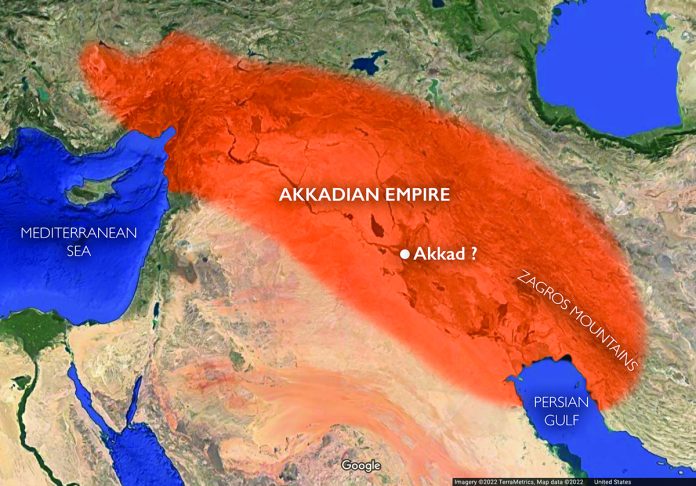Interaction Team
In the heart of ancient Mesopotamia, nestled between the Tigris and Euphrates rivers, the Akkadian Empire emerged as the world’s first empire around 2334 B.C. Under the leadership of Sargon of Akkad, this empire marked a significant turning point in the history of human civilization. As the Akkadians unified vast lands under a single rule, they established precedents in governance, military strategy, and cultural integration, shaping the future of Mesopotamian society and influencing empires for millennia to come.
The rise of Akkad
Before the rise of the Akkadian Empire, Mesopotamia was home to numerous independent city-states, each vying for power and dominance. Sargon of Akkad, born in humble beginnings, rose to power by overthrowing the king of Kish and establishing his capital in the city of Akkad. This marked the beginning of an unparalleled period of conquest and expansion. Within a short span, Sargon unified the previously fragmented city-states of Sumer, extending his influence from the Persian Gulf to the Mediterranean Sea. His empire became the first in history to bring multiple ethnic groups and regions under a centralized, authoritative rule.
Military might and strategic dominance
The Akkadian Empire’s success can largely be attributed to its advanced military tactics and organizational structure. Sargon implemented a standing army, a revolutionary concept at the time, which enabled swift and decisive military campaigns. His forces were well-trained and disciplined, making the Akkadian army one of the most formidable in the ancient world.
Sargon’s conquests were not limited to Mesopotamia; he extended his reach to Elam in the east and the Levant in the west, establishing Akkad as a dominant force in the ancient Near East.
One of the empire’s key military strategies was the use of fortified garrisons in conquered territories. This not only helped to maintain control over vast distances but also ensured a rapid response to any insurrections. By doing so, Sargon ensured the stability of his empire, allowing for long periods of peace and prosperity within its borders.
Governance and Administration
The governance of the Akkadian Empire was both innovative and far-reaching. Sargon appointed loyal officials, often members of his family, to oversee distant territories. These governors acted as extensions of the central authority, ensuring that the empire’s policies and laws were implemented uniformly across the vast regions. This decentralized form of administration allowed Sargon to maintain control over his sprawling empire.
In addition to the political governance, Sargon established a postal system to facilitate communication across the empire, enabling efficient administration. Taxation was standardized, and a tribute system was introduced to ensure a steady flow of wealth into the imperial treasury. These administrative innovations were crucial in maintaining the Akkadian Empire’s stability and prosperity over time.
Religion and ideology
Much like the Sumerians, the Akkadians believed that their rulers were chosen by the gods, and Sargon positioned himself as the divine ruler of the empire. He proclaimed himself as the “King of the Four Quarters of the World,” emphasizing his god-given authority to rule over all lands and peoples. Religion played a central role in legitimizing the Akkadian rulers’ power, and Sargon and his successors were often depicted in art and literature as being favored by the gods.
The Akkadian Empire also saw the rise of the goddess Ishtar, who became a prominent deity in the Akkadian pantheon. Temples dedicated to Ishtar were erected throughout the empire, and her worship became intertwined with the political authority of the empire’s rulers.
Cultural achievements and innovations
The Akkadian period was a time of significant cultural and intellectual advancements. Akkadian, a Semitic language, replaced Sumerian as the lingua franca of the empire. This linguistic shift was a reflection of the empire’s multi-ethnic composition, with Akkadian becoming the dominant language in administrative and diplomatic affairs.
The empire also saw advances in art and architecture. The iconic victory stele of Naram-Sin, Sargon’s grandson, depicts the ruler as a godlike figure, symbolizing the divine nature of kingship. This form of art, characterized by its bold and monumental style, became a hallmark of Akkadian culture. In architecture, the Akkadians continued the Sumerian tradition of constructing ziggurats, massive terraced structures that served as both temples and administrative centers.
THE FALL OF THE AKKADIAN EMPIRE
Despite its early success, the Akkadian Empire began to decline after the death of Sargon’s grandson, Naram-Sin. A series of internal rebellions, coupled with invasions by external forces such as the Gutians, led to the fragmentation of the empire. Environmental factors, such as drought and famine, also played a significant role in the empire’s collapse. By 2154 B.C., the Akkadian Empire had disintegrated, marking the end of an era in Mesopotamian history.
The lasting legacy of Akkad
Though the Akkadian Empire eventually fell, its influence continued to shape the civilizations that followed. The concept of a centralized empire ruled by a single authority became a model for future empires in the region, including the Babylonian and Assyrian empires.
The administrative and military innovations introduced by Sargon and his successors laid the groundwork for the governance of vast territories, while the cultural achievements of the Akkadian period left an indelible mark on Mesopotamian society.
The Akkadian Empire’s legacy is one of unity, innovation, and cultural fusion. Its rise and fall offer valuable insights into the complexities of empire-building and the challenges of maintaining power over diverse and distant lands. As the first true empire in history, Akkad stands as a testament to the enduring human pursuit of power, governance, and cultural advancement.







